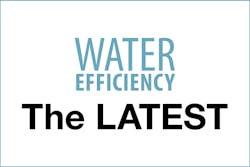California Takes Strong Steps Toward Making Water Conservation a Way of Life
State officials today released a comprehensive plan to formalize Governor Brown’s 2016 Executive Order on “Making Water Conservation a California Way of Life.”
The plan sets a strong path toward achieving the objectives of the order: using water more wisely, eliminating water waste, strengthening local drought resilience, improving agricultural water use efficiency and drought planning. It sets the stage for further Water Board work to ensure that all water is valued and used efficiently, including recycled water, and also prepares California for the realities of living with climate change, including more frequent droughts and floods similar to those we’ve seen recently.
The plan focuses on improving urban water efficiency, particularly for landscaping
eliminates wasteful practices and strengthens drought preparedness for cities, towns and rural communities emphasizes local control and decision-making by allowing each of the state’s 410 water utilities to work within a customized water budget based on population, land use, climate and other local factors that influence indoor and outdoor water use. Local utilities can choose how best to meet their targets, including through leak repair, offering rebates for more efficient showers and clothes washers, or helping customers transition to more climate appropriate landscapes
Following is a statement from Tracy Quinn, senior water policy analyst with Natural Resources Defense Council:
“Recent events at Oroville Dam and elsewhere statewide demonstrate the vulnerability of our water supply infrastructure, which can occur during both wet and dry periods, and reinforces the value of water efficiency regardless of the weather. Some of the easiest and least expensive ways to ensure that we have sustainable water supplies in the future is to increase water efficiency, fix leaks and eliminate wasteful practices like hosing down sidewalks. These are common sense fixes that mean more water for us in the long run.”
Following is a statement from Sara Aminzadeh, executive director of California Coastkeeper Alliance:
“The last five years have shown us that we can no longer take water for granted. This plan will help California end the cycle of lurching from one water crisis to the next and ensure our communities and economy can continue to thrive in an uncertain climate reality.”
Following is a statement from Cynthia Koehler, executive director of WaterNow Alliance:
“Water use efficiency and innovation have huge potential in California, and the State’s conservation plan supports local water providers in their efforts to scale up these programs and make their communities more resilient and water secure – while keeping costs affordable for ratepayers.
Following is a statement from Heather Cooley, water program director at the Pacific Institute:
“Californians have made major water conservation and efficiency improvements over the last several decades and especially during the recent drought. Without these efforts, the state’s water challenges would be much worse. The good news is that there remains additional efficiency opportunities, and the state’s plan to make conservation a California way of life will help ensure that California communities, businesses, and ecosystems have the water they need to thrive.”
Following is a statement from Laurel Firestone, co-director of Community Water Center:
“The plan helps ensure affordability of our water supplies, a major issue for low-income communities. In addition, improving drought planning and preparedness, as the plan aims to do, will help protect our most vulnerable communities from the water shortages they have seen during this drought and that will only become more common in the future.”
Following is a statement from Jonathan Parfrey, executive director of Climate Resolve:
“Climate change is bringing more extreme weather. Our dry years have become drier and our wet years have become more extreme. With water supply at risk, it’s common sense for California to conserve and make the most of every drop.”
Background
The plan released today was written by the five state agencies that will lead its implementation – the California Department of Water Resources, State Water Resources Control Board, California Public Utilities Commission, California Department of Food and Agriculture, and California Energy Commission.
Earlier this year, 36 leading water and climate scientists delivered a letter to Gov. Brown to express their support for Executive Order B-37-16 and the state’s draft plan to make water conservation a California way of life. The plan has also received support from a diverse array of stakeholders, including the Building Industry Association, Moulton Niguel Water District, Inland Empire Utilities Agency, Climate Resolve, WaterNow Alliance, California Coastkeeper Alliance, the Natural Resources Defense Council, Community Water Center, Pacific Institute, Environmental Justice Coalition for Water and the Water Foundation.
The plan has also received support from a diverse array of businesses, water agencies, environmental justice organizations and non-governmental organizations, many of whom served on the Urban Advisory Group panel who informed the development of the plan over several months.
The proposed urban water use standards are intended to build upon the conservation achieved under SBx7-7 and the emergency mandatory conservation targets. They reflect the need to transition from conservation (simply using less water) toward using water more efficiently. The state proposes to finalize the standards, which will define efficient use, by 2020. Water suppliers will then use those standards to calculate customized water use targets, which they will be required to meet by 2025. The state may also establish interim targets to ensure suppliers are on track to meet 2025 targets.
